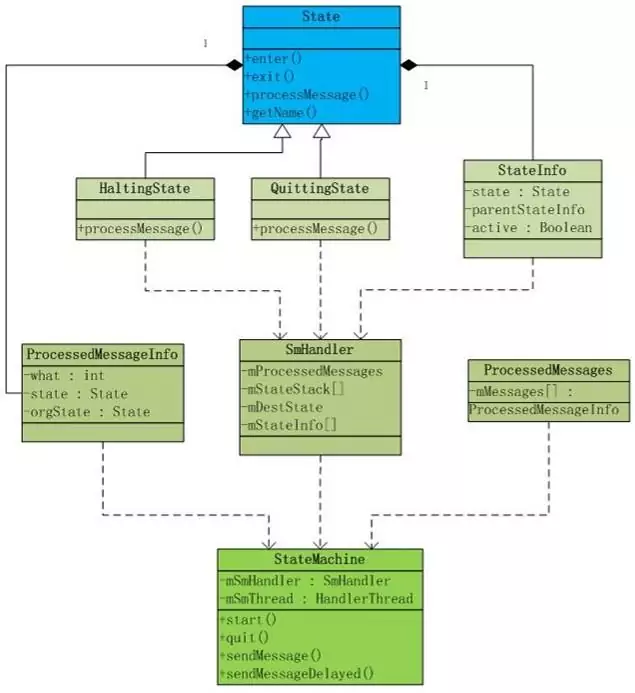状态机是一种面向对象的设计模式,用来描述对象在生命周期中的各种状态,以及它们之间的关系。状态机中每种状态只能进行某些特定的操作,且只能切换到某些状态。它的好处是使逻辑与状态机代码分离,提升代码可读性和可维护性。
一、架构
StateMachine 实现了 Android 状态机的基本逻辑,只允许 Android 系统内部调用,它的内部结构如图:

StateMachine 所实现的状态机是一种分层状态机(Hierarchical State Machine,HSM),分层管理状态和处理消息。HSM 维护一个层次结构,也就是状态树,每一层都有一个或多个状态,这些状态派生自 State,StateMachine 收到的消息会被传递至这些状态,派生一种状态需要实现其 processMessage 方法来完成该状态的消息处理逻辑。
StateMachine 所实现的状态机启动时,会构造一个状态树,固定每种状态及其父状态、子状态的关系,然后将当前状态设置为指定的初始状态,当前状态相当于一个指针,它在这棵状态树上游走。以下面的状态机层次结构为例,设 mS5 为初始状态,构造完成时,当前状态的转移路径为从 mS5 的最远父状态也就是 mP0 开始,依次经过 mP1、mS1,直到 mS5。
mP0
/ \
mP1 mS0
/ \
mS2 mS1
/ \ \
mS3 mS4 mS5
完成启动后,状态机开始处理消息。当状态机收到一个消息时,首先转给当前状态 mS5,由其 processMessage 方法处理。若子状态不能处理,消息将被转给其父状态,以此类推,状态机沿着状态树逐级上溯,直到找到一个可以处理该消息的状态,比如一条只有 mP1 才能处理的消息,会经过 mS5、mS1 再转进 mP1。如果追溯到最远父状态 mP0 依然不能处理,该消息就会被最后集中处理。
状态机内部有一个 Handler,它负责维护消息队列,并完成消息管理和分发,进入状态机的消息可以选择加入这个消息队列的头部或是尾部,每次处理消息 Handler 就从消息队列头部取出一条消息,分发给相应的状态处理。处理消息时,负责处理消息的状态可以标记要切换到的新状态,待消息处理完后,状态机会自动切换过去。
StateMachine 有两个特殊的 State:HaltingState 与 QuittingState,它们出现在状态机退出的过程中,haltingState 是停止、即将退出的状态,进入这个状态后,将不能再回到普通状态,此时 Handler 依然在运行,所有的消息由 haltedProcessMessage 方法处理;QuitingState 是退出状态,这个状态结束后,状态机线程结束,完全退出。假设当前状态依然是 mS5,停止或退出状态机时,沿着状态树先后退出 mS5、mS1、mP1、mP0,最后如果停止则进入 mHaltingState,如果退出则进入 mQuittingState。
二、代码解读
1. 状态机初始化
StateMachine 提供了三个构造方法,三个方法大同小异,构造时如果没有提供 Looper,就使用内部线程的 Looper。
protected StateMachine(String name) {
mSmThread = new HandlerThread(name);
mSmThread.start();
Looper looper = mSmThread.getLooper();
initStateMachine(name, looper);
}
StateMachine 在 Looper 所在的线程运行,状态机初始化时使用 Looper 构造一个 SmHandler,用于处理状态机的通讯。
private void initStateMachine(String name, Looper looper) {
mName = name;
mSmHandler = new SmHandler(looper, this);
}
StateMachine 是一种 HSM,需要调用 addState 方法指定它的层级关系,为指定的父状态添加子状态,如果不指定父状态,则创建一个孤立的状态节点。状态关系信息存储于 mStateInfo 中。
private final StateInfo addState(State state, State parent) {
if (mDbg) {
mSm.log("addStateInternal: E state=" + state.getName() + ",parent="
+ ((parent == null) ? "" : parent.getName()));
}
StateInfo parentStateInfo = null;
if (parent != null) {
parentStateInfo = mStateInfo.get(parent);
if (parentStateInfo == null) {
// Recursively add our parent as it's not been added yet.
parentStateInfo = addState(parent, null);
}
}
StateInfo stateInfo = mStateInfo.get(state);
if (stateInfo == null) {
stateInfo = new StateInfo();
mStateInfo.put(state, stateInfo);
}
// Validate that we aren't adding the same state in two different hierarchies.
if ((stateInfo.parentStateInfo != null)
&& (stateInfo.parentStateInfo != parentStateInfo)) {
throw new RuntimeException("state already added");
}
stateInfo.state = state;
stateInfo.parentStateInfo = parentStateInfo;
stateInfo.active = false;
if (mDbg) mSm.log("addStateInternal: X stateInfo: " + stateInfo);
return stateInfo;
}
构造完成后,调用 start 方法启动状态机,其内部调用 mSmHandler 的 completeConstruction 方法,完成状态机构造的动作。completeConstruction 方法首先遍历状态树,并找到树的最大深度,用于确定状态栈的大小,并构造初始的状态栈,所有动作完成后,发送 SM_INIT_CMD 消息,报告状态机已构造完成。
private final void completeConstruction() {
if (mDbg) mSm.log("completeConstruction: E");
/**
* Determine the maximum depth of the state hierarchy
* so we can allocate the state stacks.
*/
int maxDepth = 0;
for (StateInfo si : mStateInfo.values()) {
int depth = 0;
for (StateInfo i = si; i != null; depth++) {
i = i.parentStateInfo;
}
if (maxDepth < depth) {
maxDepth = depth;
}
}
if (mDbg) mSm.log("completeConstruction: maxDepth=" + maxDepth);
mStateStack = new StateInfo[maxDepth];
mTempStateStack = new StateInfo[maxDepth];
setupInitialStateStack();
/** Sending SM_INIT_CMD message to invoke enter methods asynchronously */
sendMessageAtFrontOfQueue(obtainMessage(SM_INIT_CMD, mSmHandlerObj));
if (mDbg) mSm.log("completeConstruction: X");
}
构造状态栈时,先构造临时状态栈,从初始状态开始,上溯状态树,依次放入临时状态栈中,直到最远父状态,最后再将临时状态栈内容以相反的顺序保存至状态栈中。
private final void setupInitialStateStack() {
if (mDbg) {
mSm.log("setupInitialStateStack: E mInitialState=" + mInitialState.getName());
}
StateInfo curStateInfo = mStateInfo.get(mInitialState);
for (mTempStateStackCount = 0; curStateInfo != null; mTempStateStackCount++) {
mTempStateStack[mTempStateStackCount] = curStateInfo;
curStateInfo = curStateInfo.parentStateInfo;
}
// Empty the StateStack
mStateStackTopIndex = -1;
moveTempStateStackToStateStack();
}
moveTempStateStackToStateStack 方法将临时状态栈按相反顺序保存到状态栈中。
private final int moveTempStateStackToStateStack() {
int startingIndex = mStateStackTopIndex + 1;
int i = mTempStateStackCount - 1;
int j = startingIndex;
while (i >= 0) {
if (mDbg) mSm.log("moveTempStackToStateStack: i=" + i + ",j=" + j);
mStateStack[j] = mTempStateStack[i];
j += 1;
i -= 1;
}
mStateStackTopIndex = j - 1;
if (mDbg) {
mSm.log("moveTempStackToStateStack: X mStateStackTop=" + mStateStackTopIndex
+ ",startingIndex=" + startingIndex + ",Top="
+ mStateStack[mStateStackTopIndex].state.getName());
}
return startingIndex;
}
SmHandler 从 Looper 取得 SM_INIT_CMD 消息,调用 handleMessage 进行处理,内部再调用 invokeEnterMethods,以进入到初始状态。
@Override
public final void handleMessage(Message msg) {
if (!mHasQuit) {
if (mSm != null && msg.what != SM_INIT_CMD && msg.what != SM_QUIT_CMD) {
mSm.onPreHandleMessage(msg);
}
if (mDbg) mSm.log("handleMessage: E msg.what=" + msg.what);
/** Save the current message */
mMsg = msg;
/** State that processed the message */
State msgProcessedState = null;
if (mIsConstructionCompleted || (mMsg.what == SM_QUIT_CMD)) {
/** Normal path */
msgProcessedState = processMsg(msg);
} else if (!mIsConstructionCompleted && (mMsg.what == SM_INIT_CMD)
&& (mMsg.obj == mSmHandlerObj)) {
/** Initial one time path. */
mIsConstructionCompleted = true;
invokeEnterMethods(0);
} else {
throw new RuntimeException("StateMachine.handleMessage: "
+ "The start method not called, received msg: " + msg);
}
performTransitions(msgProcessedState, msg);
// We need to check if mSm == null here as we could be quitting.
if (mDbg && mSm != null) mSm.log("handleMessage: X");
if (mSm != null && msg.what != SM_INIT_CMD && msg.what != SM_QUIT_CMD) {
mSm.onPostHandleMessage(msg);
}
}
}
invokeEnterMethods 的参数为一个整数,表示第一个要进入的状态在栈中的索引位置,从该位置开始依次调用每个状态的 enter 方法,直到到达栈顶。
private final void invokeEnterMethods(int stateStackEnteringIndex) {
for (int i = stateStackEnteringIndex; i <= mStateStackTopIndex; i++) {
if (stateStackEnteringIndex == mStateStackTopIndex) {
// Last enter state for transition
mTransitionInProgress = false;
}
if (mDbg) mSm.log("invokeEnterMethods: " + mStateStack[i].state.getName());
mStateStack[i].state.enter();
mStateStack[i].active = true;
}
mTransitionInProgress = false; // ensure flag set to false if no methods called
}
至此,状态机的初始化过程完成。
2. 消息处理
StateMachine 收到的消息由 mSmHandler 负责管理和分发,在 handleMessage 方法内部,收到消息并且判断 StateMachine 已经启动完成时,就会调用 mSmHandler 的 processMsg 方法,processMsg 获取状态栈栈顶——即当前状态的信息,然后调用所对应的 State 对象的 processMessage 方法,在状态内完成消息处理逻辑。若当前状态无法处理该消息,或是处理完后需要父状态继续处理,则继续调用父状态 State 对象的 processMessage 方法,直到消息处理完成,若所有父状态都不能处理,则调用 mSmHandler 的 unHandledMessage,尝试最后一次消息处理。该方法返回最后处理消息的状态,抑或是 null。
private final State processMsg(Message msg) {
StateInfo curStateInfo = mStateStack[mStateStackTopIndex];
if (mDbg) {
mSm.log("processMsg: " + curStateInfo.state.getName());
}
if (isQuit(msg)) {
transitionTo(mQuittingState);
} else {
while (!curStateInfo.state.processMessage(msg)) {
/**
* Not processed
*/
curStateInfo = curStateInfo.parentStateInfo;
if (curStateInfo == null) {
/**
* No parents left so it's not handled
*/
mSm.unhandledMessage(msg);
break;
}
if (mDbg) {
mSm.log("processMsg: " + curStateInfo.state.getName());
}
}
}
return (curStateInfo != null) ? curStateInfo.state : null;
}
3. 状态切换
每个状态在消息处理时,可以选择切换到指定状态,这个过程通过调用状态机的 transitionTo 方法触发。状态切换完成后,下一个消息将由新的状态处理。可以看到实际上是调用的 mSmHandler.transitionTo 方法。
public final void transitionTo(IState destState) {
mSmHandler.transitionTo(destState);
}
mSmHandler.transitionTo 仅标记状态切换的目标状态,实际上不会执行切换操作,这是为了在状态切换前,完成包括当前状态和一系列父状态的消息处理逻辑,待消息处理完成并返回到 mSmHandler.handleMessage 方法后再通过调用 performTransitions 方法执行切换。
/** @see StateMachine#transitionTo(IState) */
private final void transitionTo(IState destState) {
if (mTransitionInProgress) {
Log.wtf(mSm.mName, "transitionTo called while transition already in progress to " +
mDestState + ", new target state=" + destState);
}
mDestState = (State) destState;
if (mDbg) mSm.log("transitionTo: destState=" + mDestState.getName());
}
performTransitions 方法负责执行状态的切换流程。首先调用 setupTempStateStackWithStatesToEnter 方法来获得当前状态和目的状态的公共父状态,然后调用 invokeExitMethods 方法从当前状态沿状态栈逐级退出到公共父状态,再调用 invokeEnterMethods 方法从公共父状态进入到目的状态,最后调用 moveDeferredMessageAtFrontOfQueue 方法将延时消息列表的消息导入到消息队列头部。若在此过程中,目的状态发生改变,则再次执行,直到最终的状态与目的状态一致。
private void performTransitions(State msgProcessedState, Message msg) {
/**
* If transitionTo has been called, exit and then enter
* the appropriate states. We loop on this to allow
* enter and exit methods to use transitionTo.
*/
State orgState = mStateStack[mStateStackTopIndex].state;
/**
* Record whether message needs to be logged before we transition and
* and we won't log special messages SM_INIT_CMD or SM_QUIT_CMD which
* always set msg.obj to the handler.
*/
boolean recordLogMsg = mSm.recordLogRec(mMsg) && (msg.obj != mSmHandlerObj);
if (mLogRecords.logOnlyTransitions()) {
/** Record only if there is a transition */
if (mDestState != null) {
mLogRecords.add(mSm, mMsg, mSm.getLogRecString(mMsg), msgProcessedState,
orgState, mDestState);
}
} else if (recordLogMsg) {
/** Record message */
mLogRecords.add(mSm, mMsg, mSm.getLogRecString(mMsg), msgProcessedState, orgState,
mDestState);
}
State destState = mDestState;
if (destState != null) {
/**
* Process the transitions including transitions in the enter/exit methods
*/
while (true) {
if (mDbg) mSm.log("handleMessage: new destination call exit/enter");
/**
* Determine the states to exit and enter and return the
* common ancestor state of the enter/exit states. Then
* invoke the exit methods then the enter methods.
*/
StateInfo commonStateInfo = setupTempStateStackWithStatesToEnter(destState);
// flag is cleared in invokeEnterMethods before entering the target state
mTransitionInProgress = true;
invokeExitMethods(commonStateInfo);
int stateStackEnteringIndex = moveTempStateStackToStateStack();
invokeEnterMethods(stateStackEnteringIndex);
/**
* Since we have transitioned to a new state we need to have
* any deferred messages moved to the front of the message queue
* so they will be processed before any other messages in the
* message queue.
*/
moveDeferredMessageAtFrontOfQueue();
if (destState != mDestState) {
// A new mDestState so continue looping
destState = mDestState;
} else {
// No change in mDestState so we're done
break;
}
}
mDestState = null;
}
/**
* After processing all transitions check and
* see if the last transition was to quit or halt.
*/
if (destState != null) {
if (destState == mQuittingState) {
/**
* Call onQuitting to let subclasses cleanup.
*/
mSm.onQuitting();
cleanupAfterQuitting();
} else if (destState == mHaltingState) {
/**
* Call onHalting() if we've transitioned to the halting
* state. All subsequent messages will be processed in
* in the halting state which invokes haltedProcessMessage(msg);
*/
mSm.onHalting();
}
}
}
setupTempStateStackWithStatesToEnter 方法构造一个临时状态栈,其中保存状态树中目标状态到公共父状态的依赖路径,并返回栈顶的内容,即当前状态和目的状态的公共父状态,如果没有公共父状态,则返回空。
private final StateInfo setupTempStateStackWithStatesToEnter(State destState) {
/**
* Search up the parent list of the destination state for an active
* state. Use a do while() loop as the destState must always be entered
* even if it is active. This can happen if we are exiting/entering
* the current state.
*/
mTempStateStackCount = 0;
StateInfo curStateInfo = mStateInfo.get(destState);
do {
mTempStateStack[mTempStateStackCount++] = curStateInfo;
curStateInfo = curStateInfo.parentStateInfo;
} while ((curStateInfo != null) && !curStateInfo.active);
if (mDbg) {
mSm.log("setupTempStateStackWithStatesToEnter: X mTempStateStackCount="
+ mTempStateStackCount + ",curStateInfo: " + curStateInfo);
}
return curStateInfo;
}
4. 消息传递
向 StateMachine 传递消息时,最常用的是 sendMessage 方法,有多个 sendMessage 重载,但都大同小异,内部调用 mSmHandler 的 sendMessage 方法。
public void sendMessage(Message msg) {
// mSmHandler can be null if the state machine has quit.
SmHandler smh = mSmHandler;
if (smh == null) return;
smh.sendMessage(msg);
}
此外,发送消息时还可以调用 deferMessage 方法,该方法传递的消息将等待当前状态被切换后再处理,同样地,内部调用的是 mSmHandler 的 deferMessage 方法。
public final void deferMessage(Message msg) {
mSmHandler.deferMessage(msg);
}
mSmHandler 的 deferMessage 方法将消息添加到一个列表中。
private final void deferMessage(Message msg) {
if (mDbg) mSm.log("deferMessage: msg=" + msg.what);
/* Copy the "msg" to "newMsg" as "msg" will be recycled */
Message newMsg = obtainMessage();
newMsg.copyFrom(msg);
mDeferredMessages.add(newMsg);
}
在状态切换完成后,会调用 moveDeferredMessageAtFontOfQueue 方法完成消息列表更新,从列表最后的消息开始,依次放入消息队列的头部。
private final void moveDeferredMessageAtFrontOfQueue() {
/**
* The oldest messages on the deferred list must be at
* the front of the queue so start at the back, which
* as the most resent message and end with the oldest
* messages at the front of the queue.
*/
for (int i = mDeferredMessages.size() - 1; i >= 0; i--) {
Message curMsg = mDeferredMessages.get(i);
if (mDbg) mSm.log("moveDeferredMessageAtFrontOfQueue; what=" + curMsg.what);
sendMessageAtFrontOfQueue(curMsg);
}
mDeferredMessages.clear();
}
5. 状态机退出
状态机退出流程通过 quit 或 quitNow 方法触发。quit 内部调用了 mSmHandler 的 quit 方法。
public final void quit() {
// mSmHandler can be null if the state machine is already stopped.
SmHandler smh = mSmHandler;
if (smh == null) return;
smh.quit();
}
mSmHandler.quit 方法发送一个 SM_QUIT_CMD 消息,告知退出,如前文所述,该消息在处理时被传入 processMsg,直接标记切换的目标状态为 QuittingState。该状态不处理任何消息,其 processMessage 只会返回未处理。performTransitions 执行到退出状态的切换后,调用 cleanupAfterQuitting 停止状态机线程并清空状态机信息。
private final void cleanupAfterQuitting() {
if (mSm.mSmThread != null) {
// If we made the thread then quit looper which stops the thread.
getLooper().quit();
mSm.mSmThread = null;
}
mSm.mSmHandler = null;
mSm = null;
mMsg = null;
mLogRecords.cleanup();
mStateStack = null;
mTempStateStack = null;
mStateInfo.clear();
mInitialState = null;
mDestState = null;
mDeferredMessages.clear();
mHasQuit = true;
}
quitNow 方法与 quit 方法基本一致,只是将 SM_QUIT_CMD 消息放置在消息队列头部,这样状态机将不等待消息队列处理完成便立即退出。
private final void quitNow() {
if (mDbg) mSm.log("quitNow:");
sendMessageAtFrontOfQueue(obtainMessage(SM_QUIT_CMD, mSmHandlerObj));
}
此外还有停止状态 HaltingState,可通过调用 transitionToHaltingState 切换过去,该状态只是停止普通状态下的消息处理,不会停止状态机线程或清空状态机信息,消息仍可以由 haltedProcessMessage 方法处理。transitionToHaltingState 方法实际调用的是 mSmHandler.transitionTo 方法,传入的参数为 mSmHandler.mHaltingState。
public final void transitionToHaltingState() {
mSmHandler.transitionTo(mSmHandler.mHaltingState);
}

留下评论
您的电子邮箱地址并不会被展示。请填写标记为必须的字段。 *